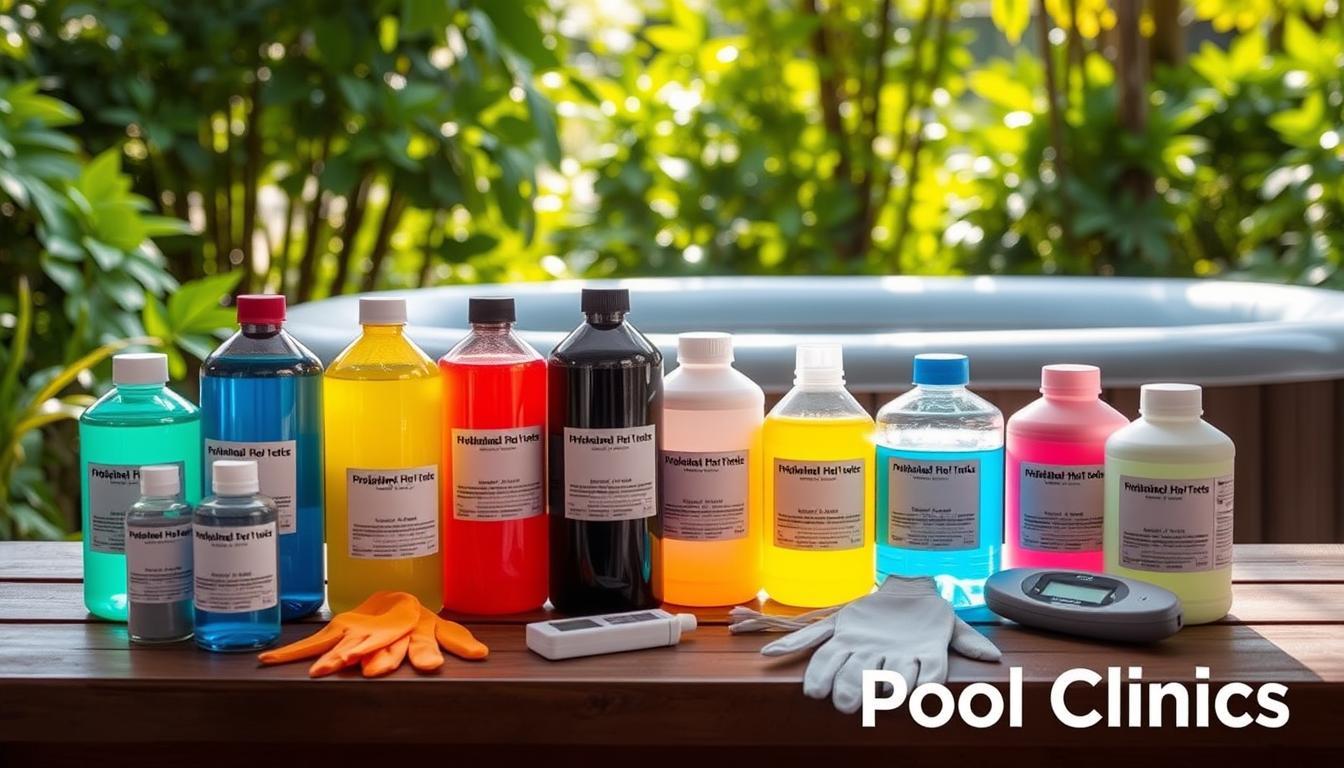
Keeping your inflatable hot tub clean and safe is crucial. The right chemicals play a vital role in maintaining the perfect environment. Let’s explore the essential chemicals for your hot tub’s health.
No one wants to soak in murky, irritating water. Using the correct chemicals prevents this nightmare scenario. It ensures your hot tub remains a safe, enjoyable oasis for everyone.
This guide will explore hot tub chemicals and their functions. You’ll learn how they work together to keep your inflatable hot tub pristine. We’ll help you maintain your hot tub’s water chemistry like a pro.
Let’s discover the essential chemicals for your inflatable hot tub. With this knowledge, you’ll ensure every soak is refreshing and worry-free.
Key Takeaways
- Inflatable hot tubs require a variety of chemicals to maintain clean and safe water, including sanitizers, pH balancers, alkalinity balancers, shock treatments, and specialized chemicals.
- Chlorine and bromine are the two most popular hot tub sanitizers, each with its own advantages and disadvantages based on factors such as skin sensitivity, odor, price, and sun exposure.
- Maintaining proper pH levels (7.2-7.8) and total alkalinity (80-120 ppm) is crucial for preventing skin irritation, corrosion, and other hot tub issues.
- Shock treatments should be performed every 1-2 weeks to destroy contaminants and keep the water clean.
- Always follow manufacturer instructions and safety precautions when handling hot tub chemicals to minimize risks and ensure the longevity of your inflatable hot tub.
Types of Chemicals for Inflatable Hot Tubs
Proper water quality is vital for a safe and fun inflatable hot tub experience. We need the right mix of chemicals to keep the water clean and balanced. Let’s look at the key chemicals for our inflatable hot tub.
Sanitizers: Chlorine, Bromine, and Mineral Options
Sanitizers are crucial for eliminating harmful bacteria and contaminants in hot tub water. Chlorine and bromine are popular choices for inflatable hot tubs. Chlorine works best at 1-3 ppm, while bromine is effective at 3-5 ppm.
Mineral sanitizers with silver or copper can provide extra support. However, they may need additional chemical sanitizers to be fully effective.
pH Balancers: Increasers and Decreasers
The right pH level is key for sanitizer effectiveness and user comfort. Ideal pH range is between 7.2 and 7.8. Hot tub pH balancers help adjust levels as needed.
Products like Hot Tub pH Increaser and Reducer ensure optimal chemical performance. They also help prevent skin and eye irritation.

Alkalinity Balancers: Maintaining Optimal Levels
Total alkalinity helps resist pH changes in the water. The proper range is typically between 80-120 ppm. Products like Hot Tub Total Alkalinity Increaser help adjust levels when needed.
Maintaining the right alkalinity ensures more stable water chemistry in our inflatable spa.
Shock Treatments: Combating High Bacterial Growth
Shock treatments eliminate built-up contaminants, organic matter, and bacteria. They’re essential for maintaining clean, clear water in inflatable hot tubs. Use them periodically or when water quality drops.
Both chlorine-based and non-chlorine shock options are available for effective treatment.
Specialized Chemicals: Clarifiers, Stain and Scale Removers, and Foam Control
Specialized products address specific issues in inflatable hot tubs. Hot tub clarifiers, like Hot Tub Sparkle Clarifier, remove small particles and improve clarity.
Stain and scale removers tackle tough mineral buildup. Foam control products, such as Hot Tub No Foam, eliminate unsightly foam from residues.
| Product | Price | Container Size |
|---|---|---|
| Hot Tub Total Alkalinity Increaser | $21.99 USD | 1KG |
| Hot Tub pH Reducer | $22.99 USD | 1KG |
| Hot Tub Sparkle Clarifier | $21.99 USD | 1L |
| Hot Tub Chlorine Granules | $23.99 USD | 1KG |
| Hot Tub No Foam | $22.99 USD | 1L |
Using these essential chemicals helps maintain a safe and enjoyable inflatable spa experience. Proper care ensures clean water for you and your guests.
Safety Precautions When Handling Hot Tub Chemicals
Safely handling chemicals is crucial for a clean, healthy inflatable hot tub. Let’s explore key safety measures for dealing with hot tub chemicals. These precautions ensure your well-being and your hot tub’s longevity.
Adding Chemicals While Tub is Running
Add chemicals while the water circulates. This prevents high chemical concentrations in one area. Follow the manufacturer’s instructions for the right amount. Overuse can cause water chemistry imbalances.
Avoiding Chemical Additions to Hot Water
Add chemicals when the water isn’t hot. High temperatures speed up reactions, making balance harder. Let the water cool to 85°F (29°C) before adding chemicals. This ensures accurate dosing and reduces risks.
Refraining from Using Body Oils or Lotions Prior to Chemical Use
Don’t use body oils or lotions before handling chemicals. These can react with chemicals, reducing their effectiveness. They can also cause scum lines and foaming in the water.
Wearing Protective Gear and Minimizing Exposure to Fumes
Wear gloves and safety goggles when handling chemicals. This prevents skin irritation and eye damage. Work in a well-ventilated area to avoid inhaling fumes.
| Protective Gear | Purpose |
|---|---|
| Gloves | Prevent skin irritation and chemical burns |
| Safety Goggles | Protect eyes from splashes and fumes |
| Face Mask | Minimize inhalation of chemical vapors |
| Long-Sleeved Clothing | Cover exposed skin to reduce contact with chemicals |
Following Manufacturer’s Instructions and Considering Skin Sensitivity
Read and follow the manufacturer’s instructions carefully. Pay attention to dosages, storage requirements, and precautions. If you have sensitive skin, consider non-chlorine alternatives.
Following these safety measures helps you enjoy a clean, safe hot tub. It also reduces risks associated with chemical exposure.
What Chemicals for Inflatable Hot Tub: Essential Considerations
Choosing chemicals for your portable hot tub requires careful thought. Your tub’s size, usage frequency, and bather count affect the right chemical balance. Let’s explore key factors for selecting essential chemicals for your inflatable spa.
- Sanitizer levels: Maintain chlorine levels between 1-3 ppm or bromine levels between 3-5 ppm to ensure effective sanitization and prevent bacterial growth.
- pH balance: Keep the pH level of your hot tub water between 7.2 and 7.8 to avoid skin irritation and damage to your inflatable spa.
- Total alkalinity: Aim for a total alkalinity level between 80 and 120 ppm to help stabilize the pH and prevent fluctuations that can cause discomfort or equipment damage.
- Shock treatments: Use specialized shock treatments, such as chlorine shock or non-chlorine shock, on a weekly basis or after heavy use to eliminate contaminants and maintain water clarity.
- Specialty chemicals: Consider using water clarifiers, stain and scale removers, and foam control agents as needed to address specific water quality issues and keep your inflatable hot tub in top condition.
Test your hot tub water often to keep it safe and comfy. Use test strips or a digital tester to check pH, sanitizer, and alkalinity levels. Add chemicals as directed by the manufacturer.
Proper chemical balance is crucial for water quality in hot tubs to prevent skin irritation, equipment damage, and poor water quality.
Use a dispenser or floater when adding chemicals to your inflatable hot tub. This helps spread chemicals evenly and protects the spa’s surface. For small to medium tubs, use 1 to 2 chlorine tablets.
| Chemical Parameter | Ideal Range | Purpose |
|---|---|---|
| Chlorine | 1-3 ppm | Primary sanitizer to kill bacteria and microorganisms |
| Bromine | 3-5 ppm | Alternative sanitizer to chlorine, effective in high temperatures |
| pH | 7.2-7.8 | Prevents skin irritation and equipment corrosion |
| Total Alkalinity | 80-120 ppm | Helps stabilize pH and prevent fluctuations |
Balancing chemicals in your inflatable hot tub is key. It ensures a safe and fun experience for you and your guests. Keep an eye on levels and adjust as needed.
Conclusion
Keeping your inflatable hot tub clean is vital for safe, enjoyable soaks. This guide helps you maintain clean, clear, and balanced water. Aim for a pH of 7.2-7.8, chlorine at 1-3 ppm, and bromine at 3-5 ppm.
Total alkalinity should be 80-120 ppm. Use water clarifiers, stain removers, and foam control products regularly. Monitor and adjust levels often, especially after heavy use.
Always use hot tub-specific chemicals and follow instructions carefully. Add chemicals weekly and change the water every 3-4 months. This ensures a healthy, hygienic environment.
Stay proactive in maintaining your hot tub’s chemistry. This will extend its life and make every soak refreshing. With this guide, you can keep your inflatable hot tub in top shape.







